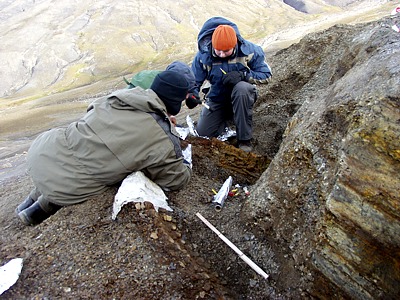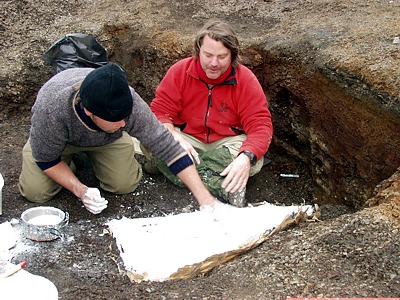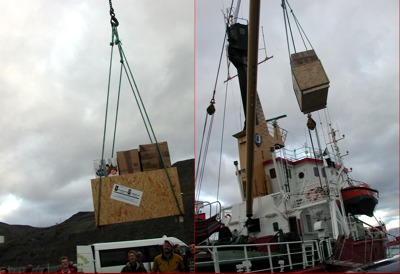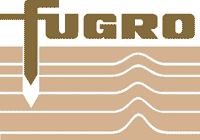PalVenn is a union for friends of the paleontological museum in Oslo , Norway . This union is an important contributor for the museum's collections by donating beautiful fossils and assisting in lab work. The museum employees work closely together with the union and provide technical assistance, a library, and tour guides. Previous PalVenn excursions have been to Sweden and around Norway , but a lot of the unions members have lng wanted to do fieldwork on Svalbard . In the occasion of PalVenn's 10 th anniversary in 2004 it was therefore decided that the next triop would go to Svalbard , and some of the members were going to assist in the excavation of the plesiosaur on the mountain Janusfjellet.
A total of five palVenn members, two students, three paleontologists from the museum, and two reporters from the Norwegian Broadcasting (NRK) were going to participate in this excavation. In advance we had arranged transport with the Norwegian Polar Institute, and despite heavy seas the group made it to Deltaneset by boat. Camp was set at a safe distance from shore, as polarbears are known to patrol the beaches looking for food, and one had been spotted in the area only days prior to the team's arrival. We had also rented a cottage from UNIS where freeze-dried meals and drinks where consumed.
Participants :
- Jørn Hurum
- Hans Arne Nakrem
- Bjørn Funke
- Magne Høyberget
- Nicolai Hernes
- Lena Kristiansen
- Mona Nyrud
- Øyvind Enger
- Stian Dale
- Stig Larsen
- Marianne Moen
- Roger Myren
The 2004 Dig
Equipped with photos and map sketches given to us by professor Jenö nagy at the University of Oslo we started searching for the plesiosaur already the first evening. The cottage was close to shore while the plesiosaur was located about 220 meters above sea level, so this was but the first of many more climbs for the next six days. The site was marked with a stick with the inscription "Dino is dead". This was because UNIS had uncovered the fossil several times, and on a black surface it was not easy to find.
The excitement was great when a piece of plastic from a shopping bag from "Svalbardbutikken" appeared few decimeters into the wet cold shale. We knew then we were in the right place and after a little digging and a few swipes with the brushes vertebra after vertebra were revealed. The row of vertebrae continued into the permafrost, so we uncovered as much as possible and during the night the ice thawed little by little making it possible to dig out more and more of the skeleton. As the bones were uncovered the geometry of the skeleton was discussed; was this the hind or front part of the animal? The debate accelerated even more when a lower jaw was revealed.
Preservation
Bones that has been encapsulated in permafrost on Svalbard slowly dissolves every time the shale thaws, and then burst into tiny pieces as the ice grows. Some ribs were found in 20-30 bits. It goes without saying that one cannot take with you all these pieces and hope that they stay in place till you get home. The team brought with them 17 kilograms of plaster bandages to use on the fossil to protect it and to keep the pieces in place during transport. The technique was to cover the fossil with wet toilet paper and then wrap it in soaked plaster bandages. Experience had taught us that plaster doesn't harden very well in low temperatures, so water was brought from the nearest stream and then heated before it was added to the bandages. This was also a lifesaver for the people who were applying the plaster with their hands in the cold weather. Maybe we could have glued together some pieces in the field and stabilized some bones then and there, but unfortunately glues that harden and sticks in the climate on Svalbard does not yet exist.
Going home
After cocooning the bones in plaster bandages the next step was to bring them down to camp. The small pieces would fit in our backpacks, but the larger pieces were put on stretches and carried by 3-4 persons. It all arrived safely in camp and were transported to Longyearbyen in a boat from the Polar Institute. The luck that had been with us so far stayed with us; in Longyearbyen we ran into an enthusiastic carpenter that had followed our expedition in the local newspaper "Svalbardposten". He made us custom made transport crates for the fossils which we jammed in the crates using a special construction foam and Rockwool. Next time fortune favored us we got contacted by geologist Hans E. F. Amundsen who was going back to Longyearbyen after a successful NASA-expedition. Their boat was stopping by Tromsø on its way and had room for our crates of valuable research material. From Tromsø the crates were sent on to Oslo , and we were releaved to see them arriving at the museum a week later.
 |
 |
 |
 |
 |
|
 |
|